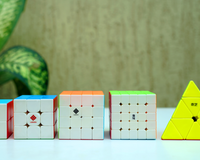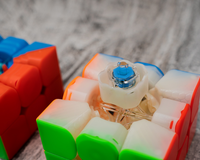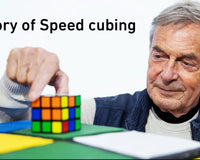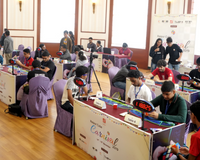Every speedcuber knows that one of the most important aspects of speedsolving is Look ahead and turning speed. But do you know what’s more important? Will turning fast get you better times or turning extremely slowly and actually looking ahead into your solve? Well, to answer this question, we must know what exactly look ahead and turning speed are and what roles do they play.
LOOK AHEAD

Look ahead is a technique in speedcubing where you look for the next pieces while solving some. For example: looking for the pieces of the first F2L pair while making the cross. Look Ahead alone is a big aspect, and to fix it you might have to fix some other areas of your solve. But in this article, I will be mainly comparing look ahead and turning speed. This technique is one of the most fundamental aspects of speedsolving, and a lot of cubers struggle. One of the reasons is a lot of people overcomplicate look ahead and think it is some sort of godly technique which only world class cubers possess genetically. Well, of course, that is not the case. And the second reason being the second point of this blog, turning speed, which is going to be covered below. Another reason can be the inefficiencies in your solves. Being the most fundamental technique, it is extremely essential to develop a good look ahead at the start of your cubing journey. This technique is not only applicable on 3x3 but for pretty much every puzzle like 4x4, 5x5, and so on.
Turning Speed

Look ahead and turning speed are techniques on two completely different spectrums, or at least I think so. The direct comparison of Look ahead and Turning speed sounds odd/ weird, but first, let me explain what turning speed is. As suggested by its name, it is the ability of a cuber to turn as fast as possible while solving a puzzle. It is not exactly a technique, but somewhat more of a physical factor. Some people have an extremely fast turning, naturally, while some have a calmer turning speed.
Look Ahead vs TPS
The reason why I compare the two techniques/ aspects is that turning speed can make or break their look ahead. Now that being said, I don’t mean someone who turns faster will have a bad look ahead for sure, but they might struggle to look ahead better. The reason being, when you turn fast, you don’t allow your brain to process what exactly is going on with the pieces while you’re solving, and hence you may pause to look for the next pieces. And on other hand, looking ahead into the solve will ultimately result in no or less amount of pauses. So a lot of cubers get stuck in this dilemma. “Should I turn fast and sacrifice look ahead or should I turn slow and give up my turning speed?” is the question we all ask at some point in our Speedcubing journey. And the answer is, you have to find the best of both worlds by practicing and developing both the techniques separately and then finding a turning speed at which you can look ahead without pausing much or at all.
How to improve look ahead?

1) As I mentioned above, turning extremely fast might be a big cause as to why you’re struggling with look ahead. And the simplest and most effective practice technique to improve look ahead is to practice slow turning UNTIMED solves. Turn as slow as you want but your solves shouldn’t have any pauses at all. Once you feel comfortable turning at that particular speed, you can start speeding up your turning incrementally and continue maintaining a proper look ahead.
2) Another way of practicing look ahead is by using a metronome. A metronome is an instrument used by musicians. You can go to cs timer and use metronome by going to the settings. A metronome gives a beat at a regular interval. You can the BPM that is beats per minute which basically means to increase or decrease the speed of the beats. So if you are using a metronome to practice look ahead, you can set the BPM (Beats per minute) to a slower bear, and then every time you hear the beat, you have to make a turn. As you get comfortable at one speed, you may increase the speed slowly and gradually till you reach a good speed with a good look ahead.
3) The third practice I would suggest is not exactly a practice, but I recommend everyone to watch a lot of walkthrough solves by different cubers who are faster than you. By seeing what other cubers do, you might pick something that you're doing inefficiently and improve your efficiency.
How to improve turning speed?

There aren’t a lot of practice techniques to develop your turning speed. The only method that worked for me was to practice triggers like R U R’U’ (sexy move), R ‘ F R F’(Sledgehammer) etc and also spamming PLL algorithms. Other than this practice method, doing solves like you normally would and more solving experience will eventually lead to a faster turning speed overtime.
Conclusion
After discussing both Look ahead and Turning speed in depth, it is very clear that one is not “better” or more important than the other. Both the aspects are equally important and you will have to give them both an equal amount of practice, and eventually find that sweet spot where your turning speed starts hindering your look ahead OR you start giving too much importance to look ahead and sacrifice the turning speed.
About Author

Aryan Chhabra
Aryan Chhabra is the current 3x3 (single) National Record holder Delhi and the first sub 5 of India. His cubing journey started at the age of 13 and now he has 6 years of cubing experience. He loves music, bodybuilding, and football. He has participated in 46 competitions in 3 countries and won 117 podiums with 56 Gold medals and 6 National Records. He also represented India in Red Bull Rubik's Cube World Cup in 2020 and 2021. He also has a World Ranking of 33 in 3x3 Single.































2 comments
Viraj Dhameja
This is an amazing blog and i used to take classes from him this is more or less what he said but written
Esther Varghese
Super